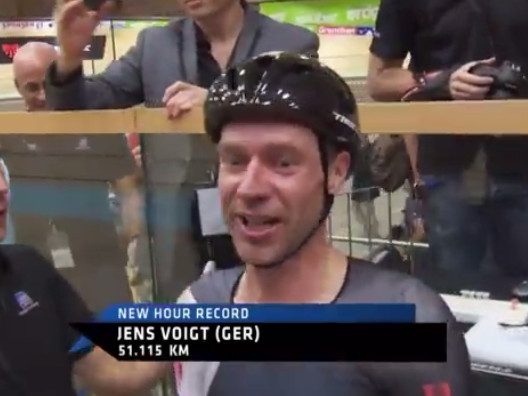Jens Voigt beats the one-hour record
On Thursday, German cyclist Jens Voigt beat the unified UCI one-hour record covering 51.115 km, 205 laps, at the Velodrome Suisse in Grenchen, Switzerland. Voigt, who turned 43 years old the day before, beat the previous record held by Czech Ondřej Sosenka (49.700 km set in 2005) by 1.415 km. The achievement follows Voigt's retirement from the pro peloton this past July, after he rode in his 17th Tour de France. He later revealed that he had been training to beat Sosenka's record.


On Thursday, German cyclist Jens Voigt beat the unified UCI one-hour record covering 51.115 km, 205 laps, at the Velodrome Suisse in Grenchen, Switzerland. Voigt, who turned 43 years old the day before, beat the previous record held by Czech Ondřej Sosenka (49.700 km set in 2005) by 1.415 km. The achievement follows Voigt’s retirement from the pro peloton this past July, after he rode in his 17th Tour de France. He later revealed that he had been training to beat Sosenka’s record.
To take on the record, the aggressive cyclist had to modify his riding style. On the road, he is known for his attacks. He’s one more for punishment (his own and others) over technique and calculation. For the record attempt, he had to rein in his instinct to push himself and deliver spikes of effort. In the leadup to the event, he focused, uncharacteristically, his training on putting out consistent power and maintaining an aerodynamic body position.
After a first lap of 24 seconds, Voigt had to maintain an average of 18 seconds per lap. At roughly three quarters through the ride, he was one and a laps ahead of his racing strategy: a final distance of 50.5 km. His heart rate had been good at the start of the attempt, but had risen to 170 b.p.m., suggesting he was straining but not at his limit. For the first half, he had averaged roughly 400 watts.
At 199 laps, he beat the record by 50 m. He then pushed on for the final 1:50, sometimes getting out of the saddle, to set the final distance of 51.115 km.
Voigt is the first rider to attempt the hour record after the UCI made changes to its rules and regulations in May. Before, riders had to use equipment as similar as possible to that used by Eddy Merckx, who set his record in 1972. This rule was a reaction by the sport’s governing body against cyclists and records set in the 1990s, such as those by Graeme Obree and Chris Boardman, who used unorthodox aerodynamic positions and novel equipment. Obree designed his own bike and adopted a “praying mantis” position. Today, the equipment rules for the hour record are similar to those of pursuit bikes for the track. Voigt’s bike was a modified Trek Speed Concept. The dropouts had to be spaced 120 mm apart to accommodate a track hub. The bike maker also worked with Shimano to create the best rear cog for Voigt’s ride.
With the new regulations in place, and a new record by a popular rider, more attempts at the hour are likely to follow. “It gives a credibility in that other people will be able to attack a valid record set by a respected rider. It brings the record alive again,” Obree said in CyclingTips. Voigt’s former teammate Fabian Cancellara has said he wants to have a go at the hour, as does Sir Bradley Wiggins.
